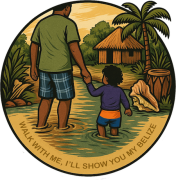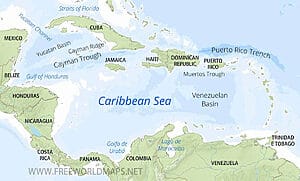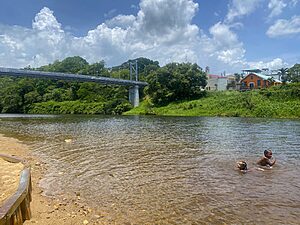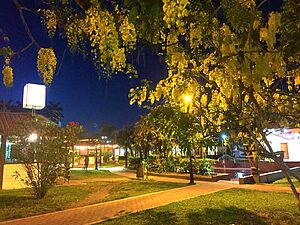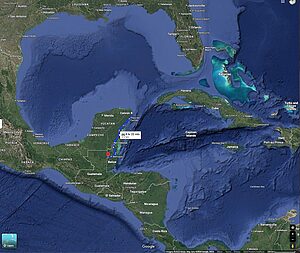🌪️ Hurricane Season in Belize: What Travelers Should Know (From a Local Guide)
Every year from June to November, Belize enters what’s known as hurricane season. For many travelers, that sounds like a warning to stay away. But as someone who’s lived here all my life—and helped guests navigate this season both as a hotel staff member and licensed guide—I can tell you: with the right knowledge, Belize is still a safe, beautiful place to visit.
🗓️ When Is Hurricane Season?
Officially, hurricane season in Belize runs from June 1 to November 30, with peak activity from August through October. That’s when warm Caribbean waters can fuel stronger storms, and locals (like my grandmother used to say) “keep one ear on the radio and one eye on the sky.”
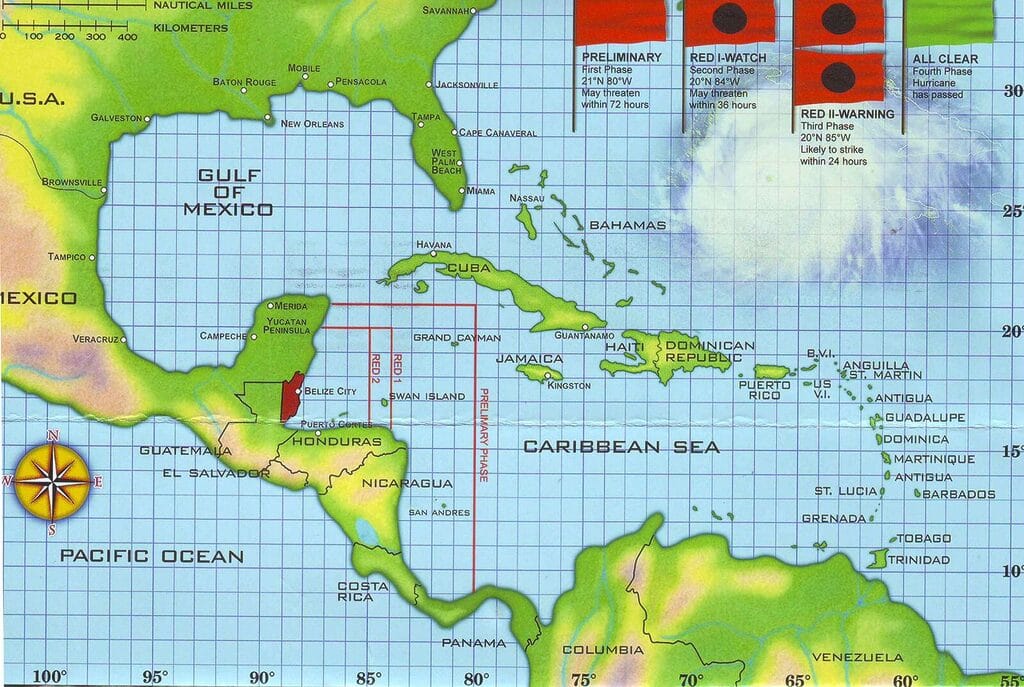
🌪️ Does Belize Get Hurricanes and How often
Yes, Belize does get hurricanes—but not as often as people think. Our coastline lies within the Caribbean hurricane belt, but direct hits are relatively rare. Most storms pass north toward Mexico or curve away into the Gulf of Mexico.
- Average frequency: One direct hit about every 6–7 years
- Major hurricanes: Category 3 or stronger are even less frequent
- Most common impacts: Heavy rains, localized flooding, and short-term travel disruptions
In fact, many years pass without Belize experiencing a hurricane at all. When storms do come, Belizeans are well-prepared with early warning systems, evacuation plans, and strong community support. Travelers are usually given plenty of notice and can adjust their plans safely.
💡 Traveler Tip: If you’re worried about timing, note that the highest risk period is late August through October. Visiting outside those months lowers the chance of encountering a storm even further.
Belize in the Atlantic and Caribbean Hurricane Belt
When people talk about hurricane season in Belize, they often mention the Atlantic hurricane belt or the Caribbean hurricane belt. These terms describe the warm waters of the Caribbean Sea and Gulf of Mexico where storms regularly form and travel.
- Atlantic Hurricane Belt: The wider zone stretching from West Africa across the Atlantic into the Caribbean and Gulf of Mexico.
- Caribbean Hurricane Belt: A more informal phrase, used by travelers and media, focusing on the Caribbean islands and coasts most affected by storms — including Belize.
Belize sits on the western edge of this hurricane belt. That means:
- We face a real risk of storms, especially in September and October.
- But compared to islands in the eastern Caribbean, Belize sees fewer direct hits — many storms curve north before reaching our shores.
- When hurricanes do arrive, they can still be powerful, as history reminds us (Hattie 1961, Iris 2001, Earl 2016).
For travelers, the important thing is context:
- Belize is in the belt, but our location makes us less exposed than many neighbors.
- Resorts, tour operators, and communities are experienced with hurricane prep.
- Planning around the season (or simply staying informed) is usually enough to enjoy Belize safely.
The Hurricane Flags in Belize
In Belize, hurricane warnings follow a clear four-step flag system. Every household knows it by heart:
- Preliminary [Red flag] – Storm may threaten Belize within 72 hours. Families buy food, water, and batteries, and resorts begin quiet preparations.
- Red I – Watch [Red flag with black dot] – Storm may threaten within 36 hours. Guests may be relocated inland, boats are secured, and shelters are prepared.
- Red II – Warning [Two red flags with black disks] – Storm likely within 24 hours. Public shelters open, and evacuation orders are carried out. Everyone is expected to stay in place.
- All Clear [Green flag] – The hurricane has passed. While winds are gone, flooding and river overflow often continue for days afterward.
This flag system is a reminder that while Belize sees fewer storms than much of the Caribbean, when the red flags go up, the country responds with discipline and unity.
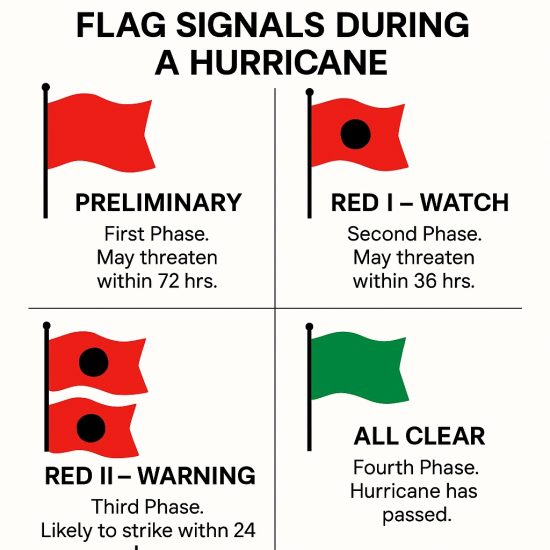
Tourism Hotspots & Hurricane Impact
Belize’s coastal tourism hubs — Ambergris Caye, Placencia, and Hopkins — each respond to hurricanes in unique ways that reflect both their geography and local resilience. Hurricanes are serious natural disasters in the Caribbean, and while Belize is a small country, every community has developed its own systems to protect residents and visitors:
- Ambergris Caye, Belize’s largest and most visited island, lies right at the edge of the barrier reef. Though less frequently hit directly, residents and tourism operators remain prepared. Resorts here regularly coordinate with mainland staff and monitor NEMO alerts to relocate guests to safer inland areas before a storm arrives.
- Placencia, situated on a slender southern peninsula, learned firsthand the dangers of compact storms when Hurricane Iris (2001) devastated the area. Today, the community utilizes practiced evacuation routes and shuttle systems to move guests inland swiftly and calmly when necessary.
- Hopkins, a growing tourism village with rich Garifuna culture, benefits from close access to Stann Creek’s inland valleys. Its outreach and preparedness culture among hotels and guides ensures that guests are safely relocated before conditions deteriorate.
Fact: Belize is about 170 miles long and 68 miles wide — which means a compact storm can devastate one coast while leaving the rest untouched. This is why hurricane preparedness is not just a precaution, but a way of life along Belize’s shores.
📊 Likelihood of Hurricanes in Belize
While every year is different, long-term records give a sense of how likely Belize is to see a storm:
| Month | Likelihood in Belize | Notes |
|---|---|---|
| June | Low | Early-season storms rarely reach this far west. |
| July | Low–Moderate | Some activity, but often curves north before Belize. |
| August | Moderate | Storms more common, but eastern Caribbean takes more hits. |
| September | Moderate–High | Peak season in the basin, but still fewer direct hits here. |
| October | High | Belize’s most dangerous month historically (Hattie, Iris). |
| November | Moderate | Lisa (2022) proved late-season storms remain a risk. |
| Dec–May | Very Low | Off-season; rare out-of-season storms possible but unlikely. |
Overall probability (per NOAA data):
- ~35% chance of a named storm passing within 50 miles of Belize in any given year.
- ~18% chance of a hurricane.
- ~8% chance of a major hurricane.
That means most years pass without a direct hit — but the risk rises sharply in October–November, when the western Caribbean becomes most active.
Flooding: Belize’s Hidden Hurricane Threat
Even when wind damage is limited, Belize’s low-lying coast and river valleys make us vulnerable to flooding. Heavy rainfall from compact storms can overwhelm drainage and river systems quickly, as seen in Lisa (2022) and Eta (2020). For travelers, this means the inland risk often comes not from storm surge, but from rivers overflowing their banks.
✅ Should You Avoid Travel During This Time?
Not necessarily. In fact, the early part of the season—June through mid-August—often brings warm weather, lush green landscapes, and fewer crowds. Just know that planning a visit between late August and October requires flexibility and awareness.
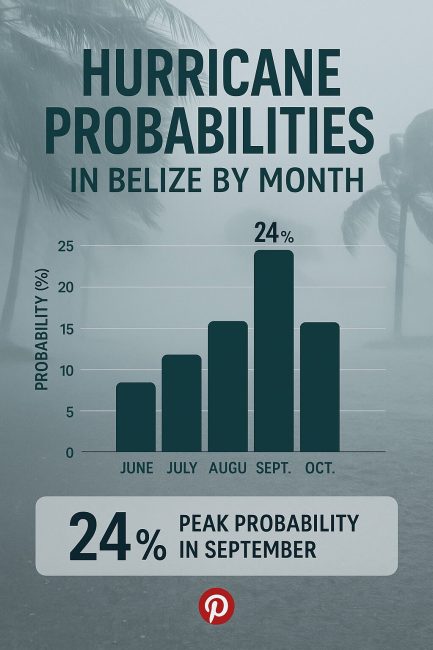
🧭 Local Travel Tips for Hurricane Season
- Watch the weather: Use apps like Windy or follow NOAA’s National Hurricane Center
- Book flexible accommodations: Ask about cancellation or rescheduling policies
- Pack for the season: A light rain jacket, bug spray, and waterproof pouches go a long way
- Travel inland if needed: Places like San Ignacio are safe zones when storms threaten the coast
- Choose providers who are prepared: Some hotels (like the one I used to work at in Placencia) have inland relocation agreements ready in case of emergency
💬 Real Belizean Insight
When I was a teen, Hurricane Iris hit our village hard. We had to evacuate by boat. Years later, I worked at The Placencia Hotel and helped evacuate guests when another storm approached. I’ve seen both sides—the panic and the calm that comes with being prepared.
Read that full story here → Surviving Hurricane Iris »
🧳 Should You Still Visit?
What This Means for Travelers
- Belize is less hurricane-prone than many Caribbean islands.
- Most storms that do reach us are late-season (Oct–Nov).
- Flooding and rain can be bigger concerns than wind.
- Resorts and tour operators are well-practiced in safety plans and will often move guests inland if needed.
The takeaway: with awareness and flexibility, you can travel safely — and in most years, Belize sees no direct hurricane at all.
👉 The Caribbean Hurricane Season »
👉 Read: Hurricane Preparedness »
See Belize Through the Seasons
Explore Belize each month
